Analysis of Factors Influencing IT-Business Strategic Alignment
VerifiedAdded on 2022/08/12
|29
|7634
|27
Report
AI Summary
This report delves into the critical factors that influence the level of IT-business strategic alignment, a topic of paramount importance in today's data-driven business landscape. The study begins by establishing the significance of aligning information technology with business strategies, highlighting the role of IT in enhancing efficiency, revenue growth, and competitiveness. The research employs a positivism research philosophy and a deductive approach, utilizing a questionnaire to gather data on various influencing factors. The report examines the impact of IT governance, organizational culture, and IT skills on business outcomes. It explores the evolution of IT applications and their strategic uses, emphasizing the importance of information resources as strategic tools. The methodology section outlines the research design, data collection methods, and analysis techniques. The literature review provides definitions of key terms such as information technology, strategic management, and IT-business alignment. The research aims to identify the factors that influence IT-business strategic alignment in the contemporary industrial sector, including the importance of management style, organizational culture, and IT skills. The report emphasizes the need for strategic planning and the potential drawbacks of misalignment. The findings are expected to provide insights into how organizations can improve their IT-business strategic alignment to achieve organizational excellence. The report concludes with a comprehensive analysis of the factors influencing the level of IT-business strategic alignment and its impact on organizational success.

Running head: IT-BUSINESS STRATEGIC ALIGNMENT
Factors Influencing the Level of IT-Business Strategic Alignment
Name of the Student:
Name of the University:
Author note:
Factors Influencing the Level of IT-Business Strategic Alignment
Name of the Student:
Name of the University:
Author note:
Paraphrase This Document
Need a fresh take? Get an instant paraphrase of this document with our AI Paraphraser
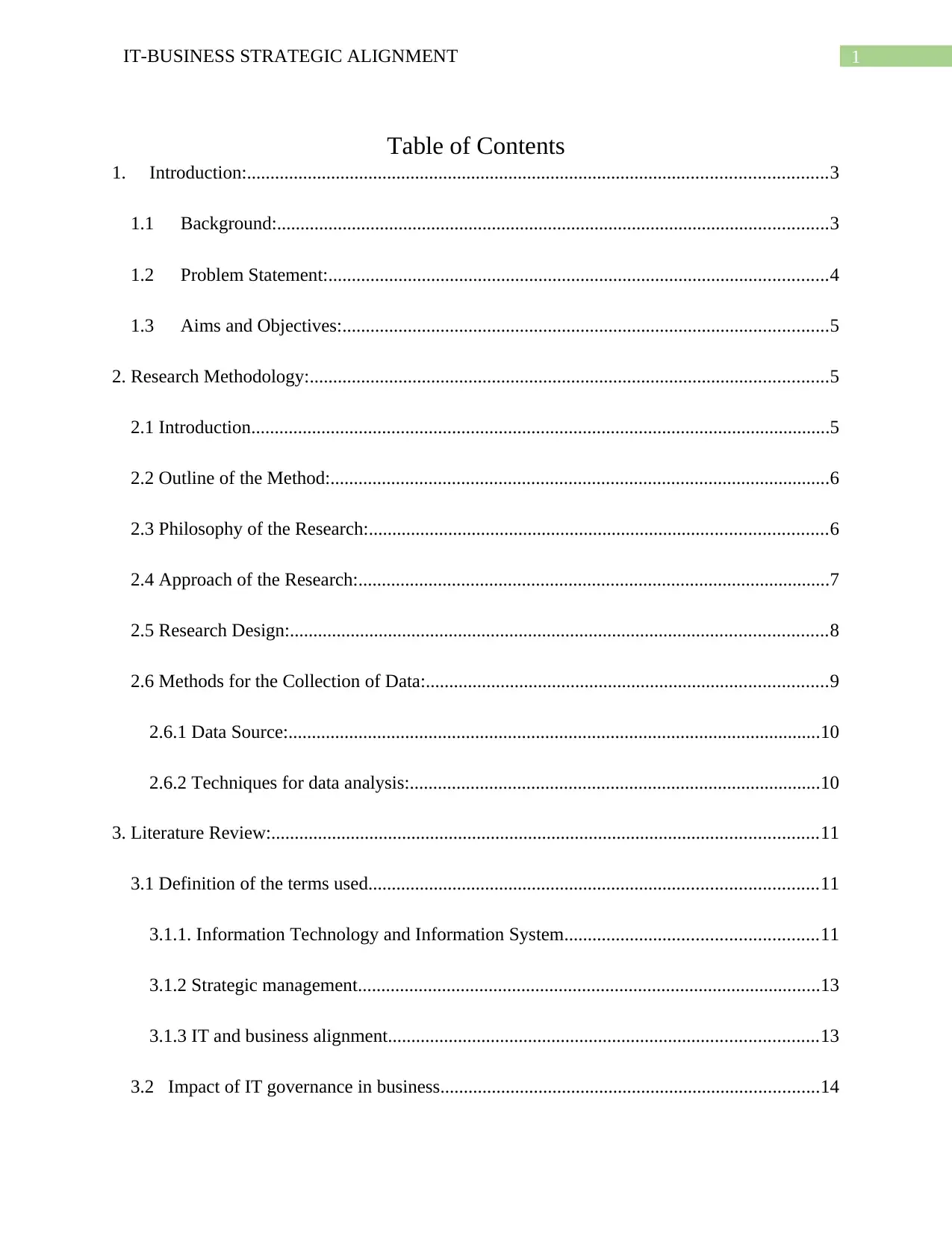
1IT-BUSINESS STRATEGIC ALIGNMENT
Table of Contents
1. Introduction:............................................................................................................................3
1.1 Background:......................................................................................................................3
1.2 Problem Statement:...........................................................................................................4
1.3 Aims and Objectives:........................................................................................................5
2. Research Methodology:...............................................................................................................5
2.1 Introduction............................................................................................................................5
2.2 Outline of the Method:...........................................................................................................6
2.3 Philosophy of the Research:..................................................................................................6
2.4 Approach of the Research:.....................................................................................................7
2.5 Research Design:...................................................................................................................8
2.6 Methods for the Collection of Data:......................................................................................9
2.6.1 Data Source:..................................................................................................................10
2.6.2 Techniques for data analysis:........................................................................................10
3. Literature Review:.....................................................................................................................11
3.1 Definition of the terms used................................................................................................11
3.1.1. Information Technology and Information System......................................................11
3.1.2 Strategic management...................................................................................................13
3.1.3 IT and business alignment............................................................................................13
3.2 Impact of IT governance in business.................................................................................14
Table of Contents
1. Introduction:............................................................................................................................3
1.1 Background:......................................................................................................................3
1.2 Problem Statement:...........................................................................................................4
1.3 Aims and Objectives:........................................................................................................5
2. Research Methodology:...............................................................................................................5
2.1 Introduction............................................................................................................................5
2.2 Outline of the Method:...........................................................................................................6
2.3 Philosophy of the Research:..................................................................................................6
2.4 Approach of the Research:.....................................................................................................7
2.5 Research Design:...................................................................................................................8
2.6 Methods for the Collection of Data:......................................................................................9
2.6.1 Data Source:..................................................................................................................10
2.6.2 Techniques for data analysis:........................................................................................10
3. Literature Review:.....................................................................................................................11
3.1 Definition of the terms used................................................................................................11
3.1.1. Information Technology and Information System......................................................11
3.1.2 Strategic management...................................................................................................13
3.1.3 IT and business alignment............................................................................................13
3.2 Impact of IT governance in business.................................................................................14
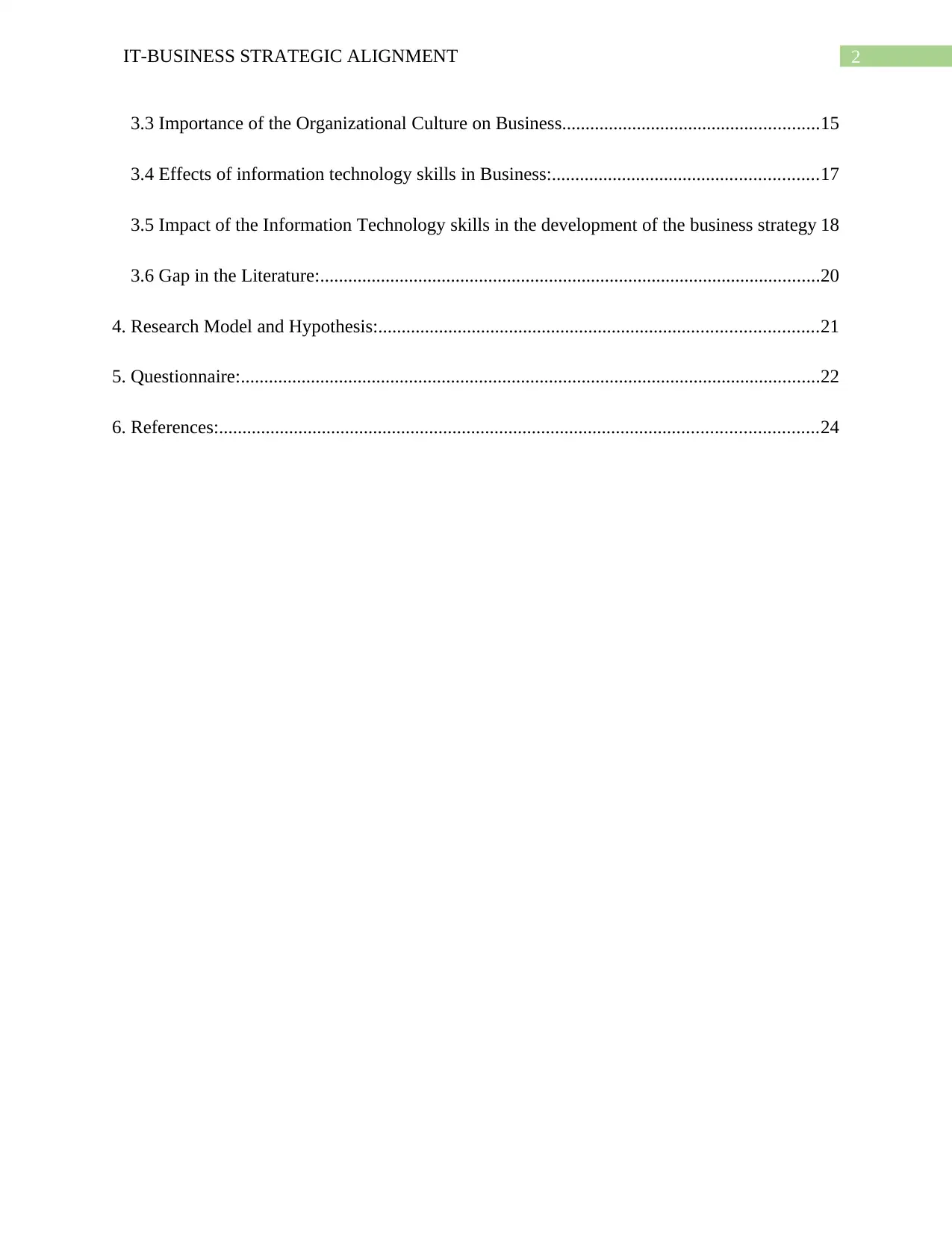
2IT-BUSINESS STRATEGIC ALIGNMENT
3.3 Importance of the Organizational Culture on Business.......................................................15
3.4 Effects of information technology skills in Business:.........................................................17
3.5 Impact of the Information Technology skills in the development of the business strategy 18
3.6 Gap in the Literature:...........................................................................................................20
4. Research Model and Hypothesis:..............................................................................................21
5. Questionnaire:............................................................................................................................22
6. References:................................................................................................................................24
3.3 Importance of the Organizational Culture on Business.......................................................15
3.4 Effects of information technology skills in Business:.........................................................17
3.5 Impact of the Information Technology skills in the development of the business strategy 18
3.6 Gap in the Literature:...........................................................................................................20
4. Research Model and Hypothesis:..............................................................................................21
5. Questionnaire:............................................................................................................................22
6. References:................................................................................................................................24
⊘ This is a preview!⊘
Do you want full access?
Subscribe today to unlock all pages.

Trusted by 1+ million students worldwide
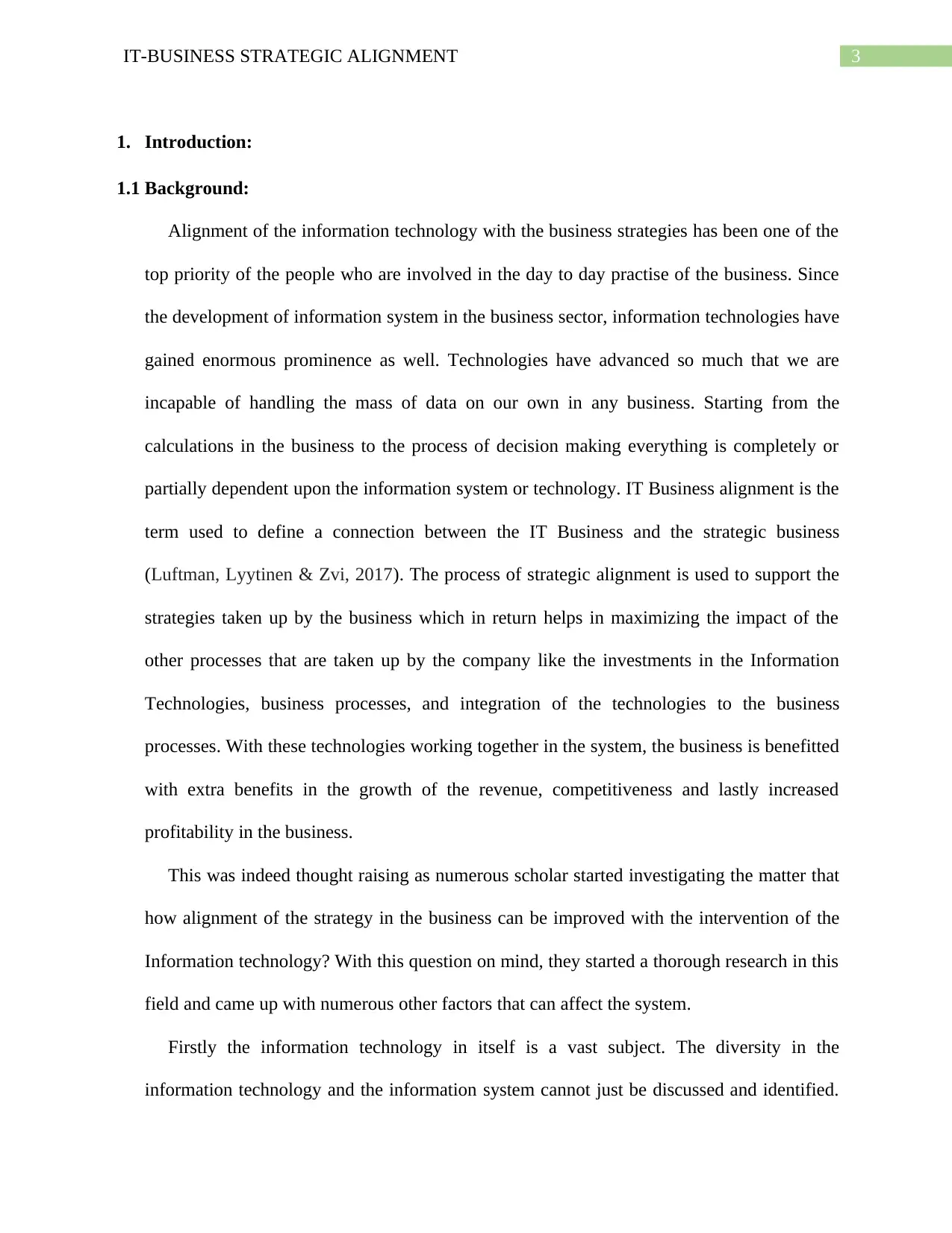
3IT-BUSINESS STRATEGIC ALIGNMENT
1. Introduction:
1.1 Background:
Alignment of the information technology with the business strategies has been one of the
top priority of the people who are involved in the day to day practise of the business. Since
the development of information system in the business sector, information technologies have
gained enormous prominence as well. Technologies have advanced so much that we are
incapable of handling the mass of data on our own in any business. Starting from the
calculations in the business to the process of decision making everything is completely or
partially dependent upon the information system or technology. IT Business alignment is the
term used to define a connection between the IT Business and the strategic business
(Luftman, Lyytinen & Zvi, 2017). The process of strategic alignment is used to support the
strategies taken up by the business which in return helps in maximizing the impact of the
other processes that are taken up by the company like the investments in the Information
Technologies, business processes, and integration of the technologies to the business
processes. With these technologies working together in the system, the business is benefitted
with extra benefits in the growth of the revenue, competitiveness and lastly increased
profitability in the business.
This was indeed thought raising as numerous scholar started investigating the matter that
how alignment of the strategy in the business can be improved with the intervention of the
Information technology? With this question on mind, they started a thorough research in this
field and came up with numerous other factors that can affect the system.
Firstly the information technology in itself is a vast subject. The diversity in the
information technology and the information system cannot just be discussed and identified.
1. Introduction:
1.1 Background:
Alignment of the information technology with the business strategies has been one of the
top priority of the people who are involved in the day to day practise of the business. Since
the development of information system in the business sector, information technologies have
gained enormous prominence as well. Technologies have advanced so much that we are
incapable of handling the mass of data on our own in any business. Starting from the
calculations in the business to the process of decision making everything is completely or
partially dependent upon the information system or technology. IT Business alignment is the
term used to define a connection between the IT Business and the strategic business
(Luftman, Lyytinen & Zvi, 2017). The process of strategic alignment is used to support the
strategies taken up by the business which in return helps in maximizing the impact of the
other processes that are taken up by the company like the investments in the Information
Technologies, business processes, and integration of the technologies to the business
processes. With these technologies working together in the system, the business is benefitted
with extra benefits in the growth of the revenue, competitiveness and lastly increased
profitability in the business.
This was indeed thought raising as numerous scholar started investigating the matter that
how alignment of the strategy in the business can be improved with the intervention of the
Information technology? With this question on mind, they started a thorough research in this
field and came up with numerous other factors that can affect the system.
Firstly the information technology in itself is a vast subject. The diversity in the
information technology and the information system cannot just be discussed and identified.
Paraphrase This Document
Need a fresh take? Get an instant paraphrase of this document with our AI Paraphraser
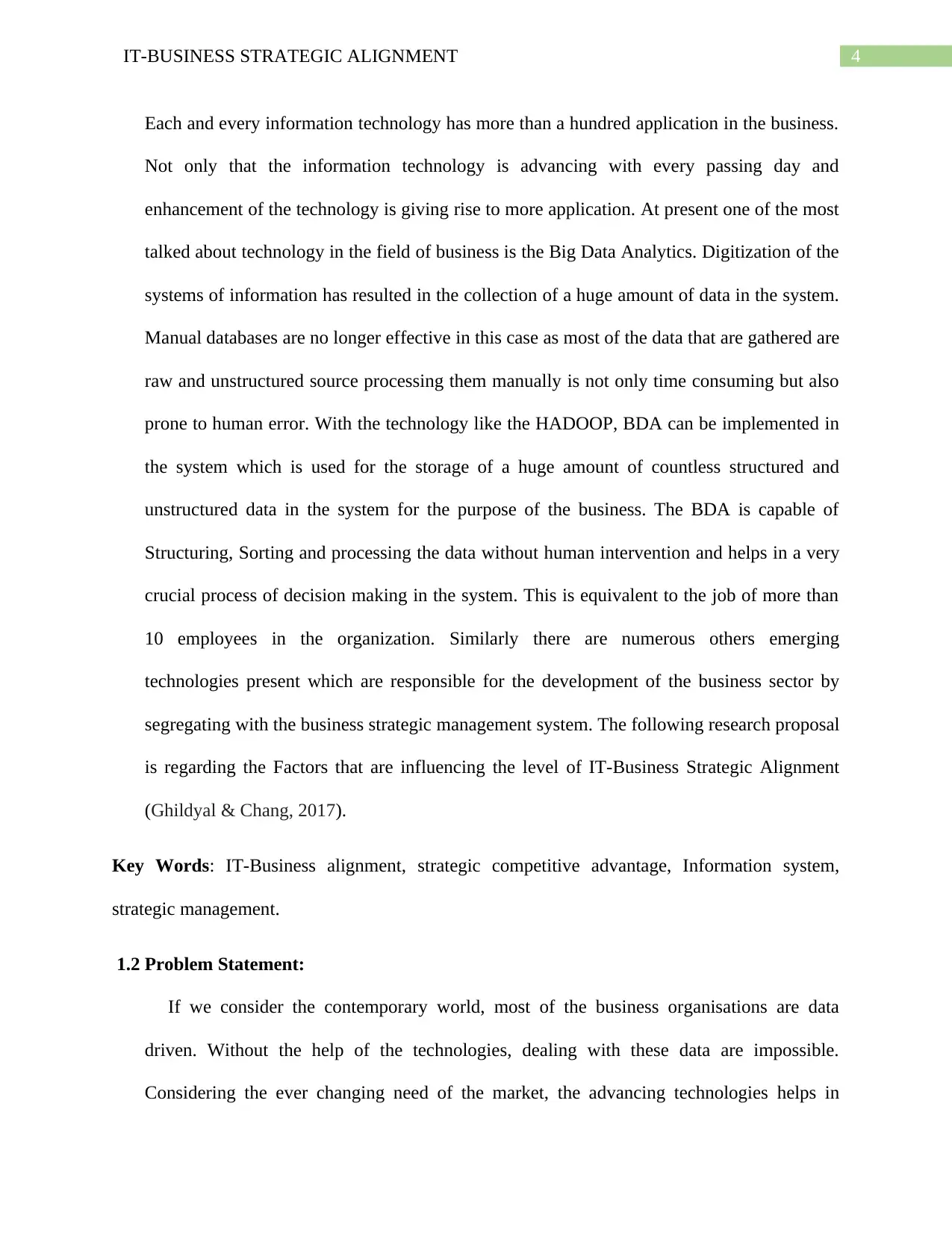
4IT-BUSINESS STRATEGIC ALIGNMENT
Each and every information technology has more than a hundred application in the business.
Not only that the information technology is advancing with every passing day and
enhancement of the technology is giving rise to more application. At present one of the most
talked about technology in the field of business is the Big Data Analytics. Digitization of the
systems of information has resulted in the collection of a huge amount of data in the system.
Manual databases are no longer effective in this case as most of the data that are gathered are
raw and unstructured source processing them manually is not only time consuming but also
prone to human error. With the technology like the HADOOP, BDA can be implemented in
the system which is used for the storage of a huge amount of countless structured and
unstructured data in the system for the purpose of the business. The BDA is capable of
Structuring, Sorting and processing the data without human intervention and helps in a very
crucial process of decision making in the system. This is equivalent to the job of more than
10 employees in the organization. Similarly there are numerous others emerging
technologies present which are responsible for the development of the business sector by
segregating with the business strategic management system. The following research proposal
is regarding the Factors that are influencing the level of IT-Business Strategic Alignment
(Ghildyal & Chang, 2017).
Key Words: IT-Business alignment, strategic competitive advantage, Information system,
strategic management.
1.2 Problem Statement:
If we consider the contemporary world, most of the business organisations are data
driven. Without the help of the technologies, dealing with these data are impossible.
Considering the ever changing need of the market, the advancing technologies helps in
Each and every information technology has more than a hundred application in the business.
Not only that the information technology is advancing with every passing day and
enhancement of the technology is giving rise to more application. At present one of the most
talked about technology in the field of business is the Big Data Analytics. Digitization of the
systems of information has resulted in the collection of a huge amount of data in the system.
Manual databases are no longer effective in this case as most of the data that are gathered are
raw and unstructured source processing them manually is not only time consuming but also
prone to human error. With the technology like the HADOOP, BDA can be implemented in
the system which is used for the storage of a huge amount of countless structured and
unstructured data in the system for the purpose of the business. The BDA is capable of
Structuring, Sorting and processing the data without human intervention and helps in a very
crucial process of decision making in the system. This is equivalent to the job of more than
10 employees in the organization. Similarly there are numerous others emerging
technologies present which are responsible for the development of the business sector by
segregating with the business strategic management system. The following research proposal
is regarding the Factors that are influencing the level of IT-Business Strategic Alignment
(Ghildyal & Chang, 2017).
Key Words: IT-Business alignment, strategic competitive advantage, Information system,
strategic management.
1.2 Problem Statement:
If we consider the contemporary world, most of the business organisations are data
driven. Without the help of the technologies, dealing with these data are impossible.
Considering the ever changing need of the market, the advancing technologies helps in
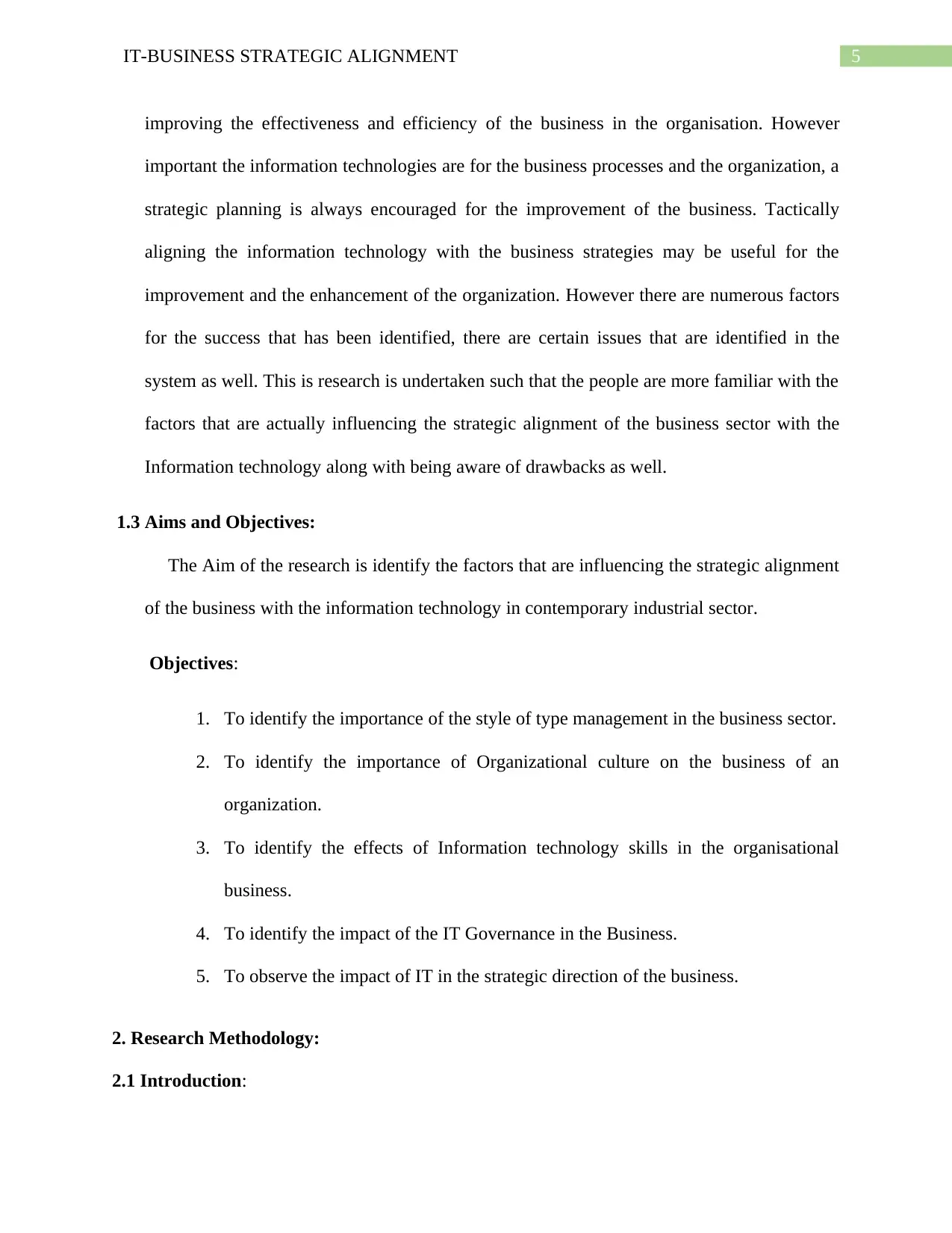
5IT-BUSINESS STRATEGIC ALIGNMENT
improving the effectiveness and efficiency of the business in the organisation. However
important the information technologies are for the business processes and the organization, a
strategic planning is always encouraged for the improvement of the business. Tactically
aligning the information technology with the business strategies may be useful for the
improvement and the enhancement of the organization. However there are numerous factors
for the success that has been identified, there are certain issues that are identified in the
system as well. This is research is undertaken such that the people are more familiar with the
factors that are actually influencing the strategic alignment of the business sector with the
Information technology along with being aware of drawbacks as well.
1.3 Aims and Objectives:
The Aim of the research is identify the factors that are influencing the strategic alignment
of the business with the information technology in contemporary industrial sector.
Objectives:
1. To identify the importance of the style of type management in the business sector.
2. To identify the importance of Organizational culture on the business of an
organization.
3. To identify the effects of Information technology skills in the organisational
business.
4. To identify the impact of the IT Governance in the Business.
5. To observe the impact of IT in the strategic direction of the business.
2. Research Methodology:
2.1 Introduction:
improving the effectiveness and efficiency of the business in the organisation. However
important the information technologies are for the business processes and the organization, a
strategic planning is always encouraged for the improvement of the business. Tactically
aligning the information technology with the business strategies may be useful for the
improvement and the enhancement of the organization. However there are numerous factors
for the success that has been identified, there are certain issues that are identified in the
system as well. This is research is undertaken such that the people are more familiar with the
factors that are actually influencing the strategic alignment of the business sector with the
Information technology along with being aware of drawbacks as well.
1.3 Aims and Objectives:
The Aim of the research is identify the factors that are influencing the strategic alignment
of the business with the information technology in contemporary industrial sector.
Objectives:
1. To identify the importance of the style of type management in the business sector.
2. To identify the importance of Organizational culture on the business of an
organization.
3. To identify the effects of Information technology skills in the organisational
business.
4. To identify the impact of the IT Governance in the Business.
5. To observe the impact of IT in the strategic direction of the business.
2. Research Methodology:
2.1 Introduction:
⊘ This is a preview!⊘
Do you want full access?
Subscribe today to unlock all pages.

Trusted by 1+ million students worldwide
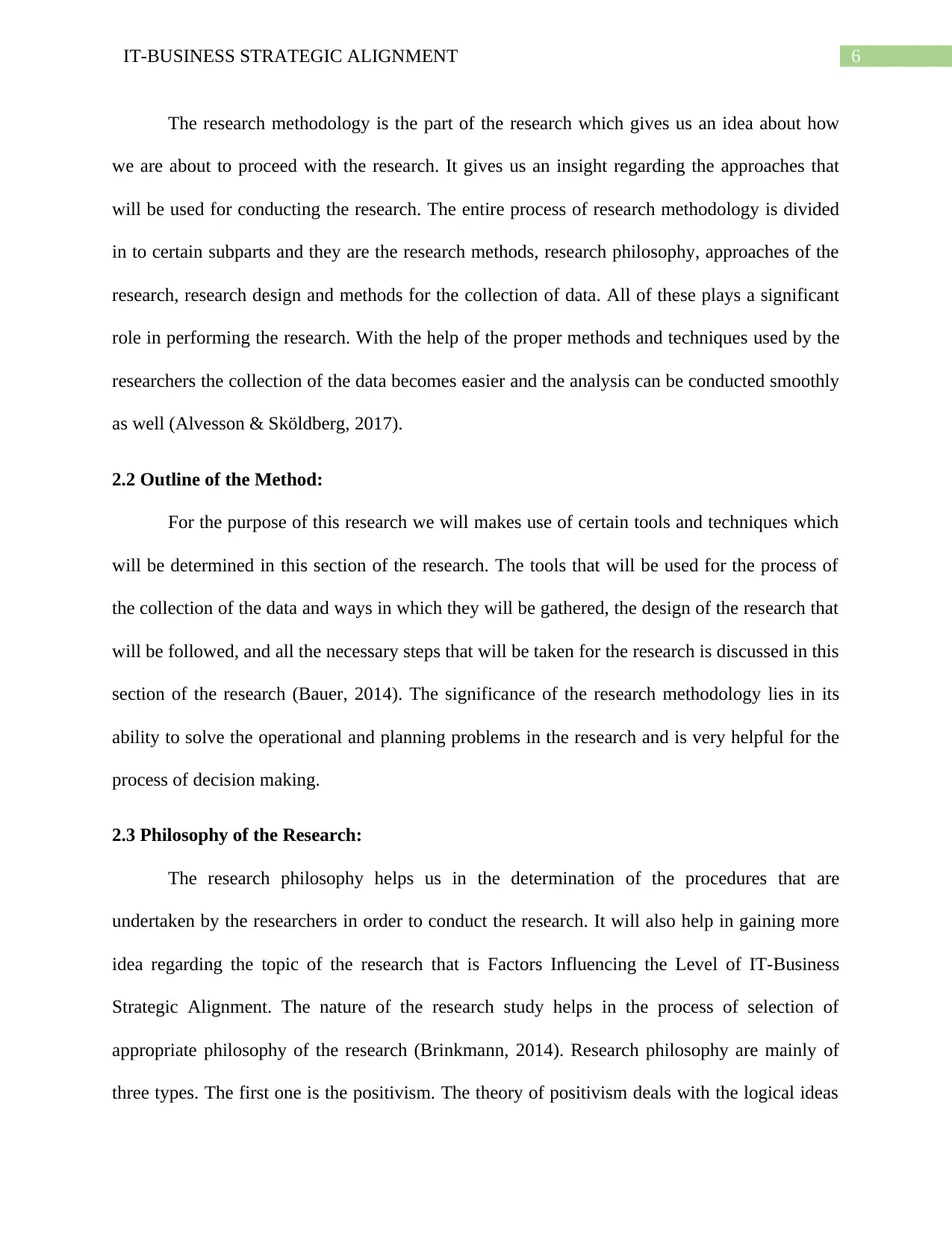
6IT-BUSINESS STRATEGIC ALIGNMENT
The research methodology is the part of the research which gives us an idea about how
we are about to proceed with the research. It gives us an insight regarding the approaches that
will be used for conducting the research. The entire process of research methodology is divided
in to certain subparts and they are the research methods, research philosophy, approaches of the
research, research design and methods for the collection of data. All of these plays a significant
role in performing the research. With the help of the proper methods and techniques used by the
researchers the collection of the data becomes easier and the analysis can be conducted smoothly
as well (Alvesson & Sköldberg, 2017).
2.2 Outline of the Method:
For the purpose of this research we will makes use of certain tools and techniques which
will be determined in this section of the research. The tools that will be used for the process of
the collection of the data and ways in which they will be gathered, the design of the research that
will be followed, and all the necessary steps that will be taken for the research is discussed in this
section of the research (Bauer, 2014). The significance of the research methodology lies in its
ability to solve the operational and planning problems in the research and is very helpful for the
process of decision making.
2.3 Philosophy of the Research:
The research philosophy helps us in the determination of the procedures that are
undertaken by the researchers in order to conduct the research. It will also help in gaining more
idea regarding the topic of the research that is Factors Influencing the Level of IT-Business
Strategic Alignment. The nature of the research study helps in the process of selection of
appropriate philosophy of the research (Brinkmann, 2014). Research philosophy are mainly of
three types. The first one is the positivism. The theory of positivism deals with the logical ideas
The research methodology is the part of the research which gives us an idea about how
we are about to proceed with the research. It gives us an insight regarding the approaches that
will be used for conducting the research. The entire process of research methodology is divided
in to certain subparts and they are the research methods, research philosophy, approaches of the
research, research design and methods for the collection of data. All of these plays a significant
role in performing the research. With the help of the proper methods and techniques used by the
researchers the collection of the data becomes easier and the analysis can be conducted smoothly
as well (Alvesson & Sköldberg, 2017).
2.2 Outline of the Method:
For the purpose of this research we will makes use of certain tools and techniques which
will be determined in this section of the research. The tools that will be used for the process of
the collection of the data and ways in which they will be gathered, the design of the research that
will be followed, and all the necessary steps that will be taken for the research is discussed in this
section of the research (Bauer, 2014). The significance of the research methodology lies in its
ability to solve the operational and planning problems in the research and is very helpful for the
process of decision making.
2.3 Philosophy of the Research:
The research philosophy helps us in the determination of the procedures that are
undertaken by the researchers in order to conduct the research. It will also help in gaining more
idea regarding the topic of the research that is Factors Influencing the Level of IT-Business
Strategic Alignment. The nature of the research study helps in the process of selection of
appropriate philosophy of the research (Brinkmann, 2014). Research philosophy are mainly of
three types. The first one is the positivism. The theory of positivism deals with the logical ideas
Paraphrase This Document
Need a fresh take? Get an instant paraphrase of this document with our AI Paraphraser
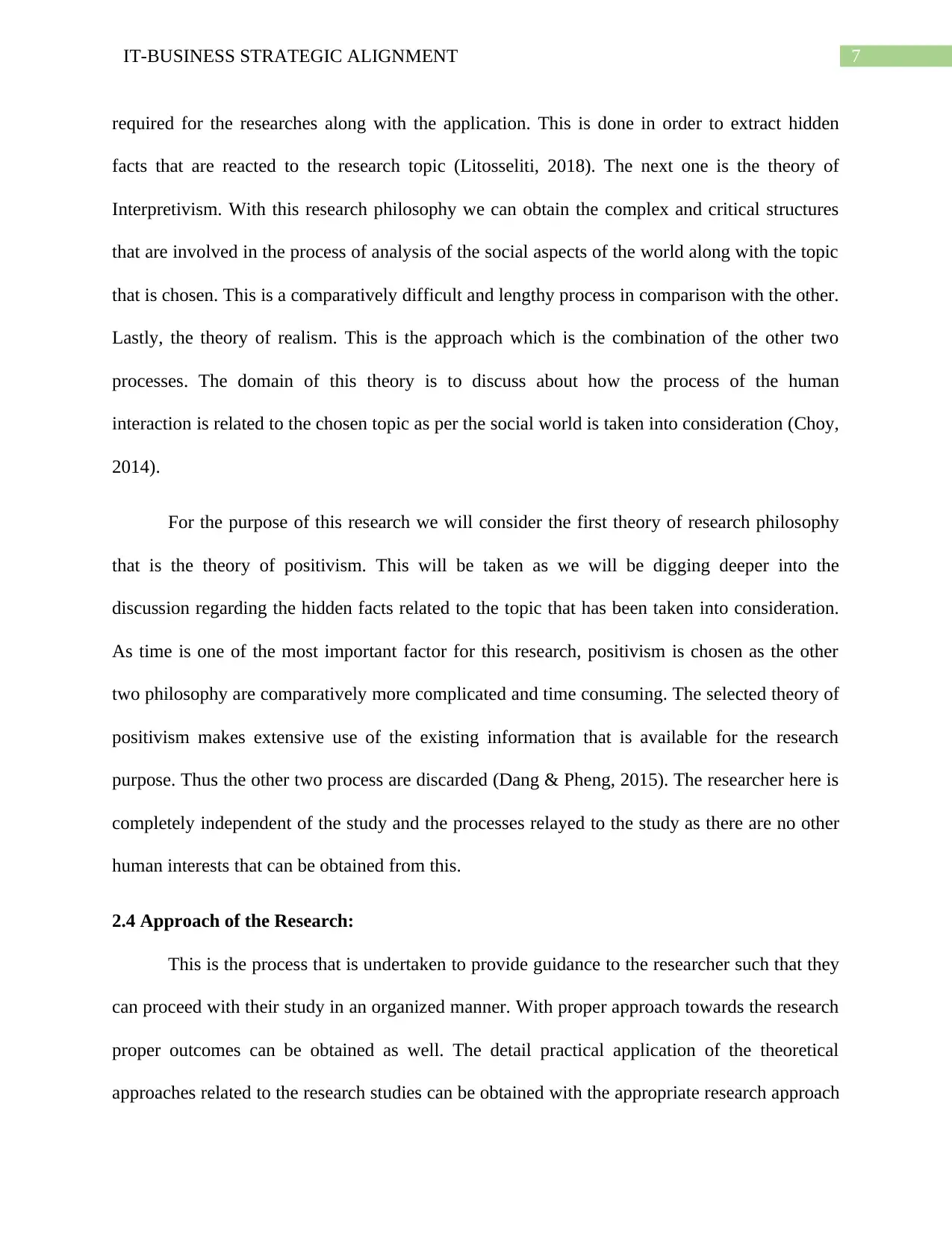
7IT-BUSINESS STRATEGIC ALIGNMENT
required for the researches along with the application. This is done in order to extract hidden
facts that are reacted to the research topic (Litosseliti, 2018). The next one is the theory of
Interpretivism. With this research philosophy we can obtain the complex and critical structures
that are involved in the process of analysis of the social aspects of the world along with the topic
that is chosen. This is a comparatively difficult and lengthy process in comparison with the other.
Lastly, the theory of realism. This is the approach which is the combination of the other two
processes. The domain of this theory is to discuss about how the process of the human
interaction is related to the chosen topic as per the social world is taken into consideration (Choy,
2014).
For the purpose of this research we will consider the first theory of research philosophy
that is the theory of positivism. This will be taken as we will be digging deeper into the
discussion regarding the hidden facts related to the topic that has been taken into consideration.
As time is one of the most important factor for this research, positivism is chosen as the other
two philosophy are comparatively more complicated and time consuming. The selected theory of
positivism makes extensive use of the existing information that is available for the research
purpose. Thus the other two process are discarded (Dang & Pheng, 2015). The researcher here is
completely independent of the study and the processes relayed to the study as there are no other
human interests that can be obtained from this.
2.4 Approach of the Research:
This is the process that is undertaken to provide guidance to the researcher such that they
can proceed with their study in an organized manner. With proper approach towards the research
proper outcomes can be obtained as well. The detail practical application of the theoretical
approaches related to the research studies can be obtained with the appropriate research approach
required for the researches along with the application. This is done in order to extract hidden
facts that are reacted to the research topic (Litosseliti, 2018). The next one is the theory of
Interpretivism. With this research philosophy we can obtain the complex and critical structures
that are involved in the process of analysis of the social aspects of the world along with the topic
that is chosen. This is a comparatively difficult and lengthy process in comparison with the other.
Lastly, the theory of realism. This is the approach which is the combination of the other two
processes. The domain of this theory is to discuss about how the process of the human
interaction is related to the chosen topic as per the social world is taken into consideration (Choy,
2014).
For the purpose of this research we will consider the first theory of research philosophy
that is the theory of positivism. This will be taken as we will be digging deeper into the
discussion regarding the hidden facts related to the topic that has been taken into consideration.
As time is one of the most important factor for this research, positivism is chosen as the other
two philosophy are comparatively more complicated and time consuming. The selected theory of
positivism makes extensive use of the existing information that is available for the research
purpose. Thus the other two process are discarded (Dang & Pheng, 2015). The researcher here is
completely independent of the study and the processes relayed to the study as there are no other
human interests that can be obtained from this.
2.4 Approach of the Research:
This is the process that is undertaken to provide guidance to the researcher such that they
can proceed with their study in an organized manner. With proper approach towards the research
proper outcomes can be obtained as well. The detail practical application of the theoretical
approaches related to the research studies can be obtained with the appropriate research approach
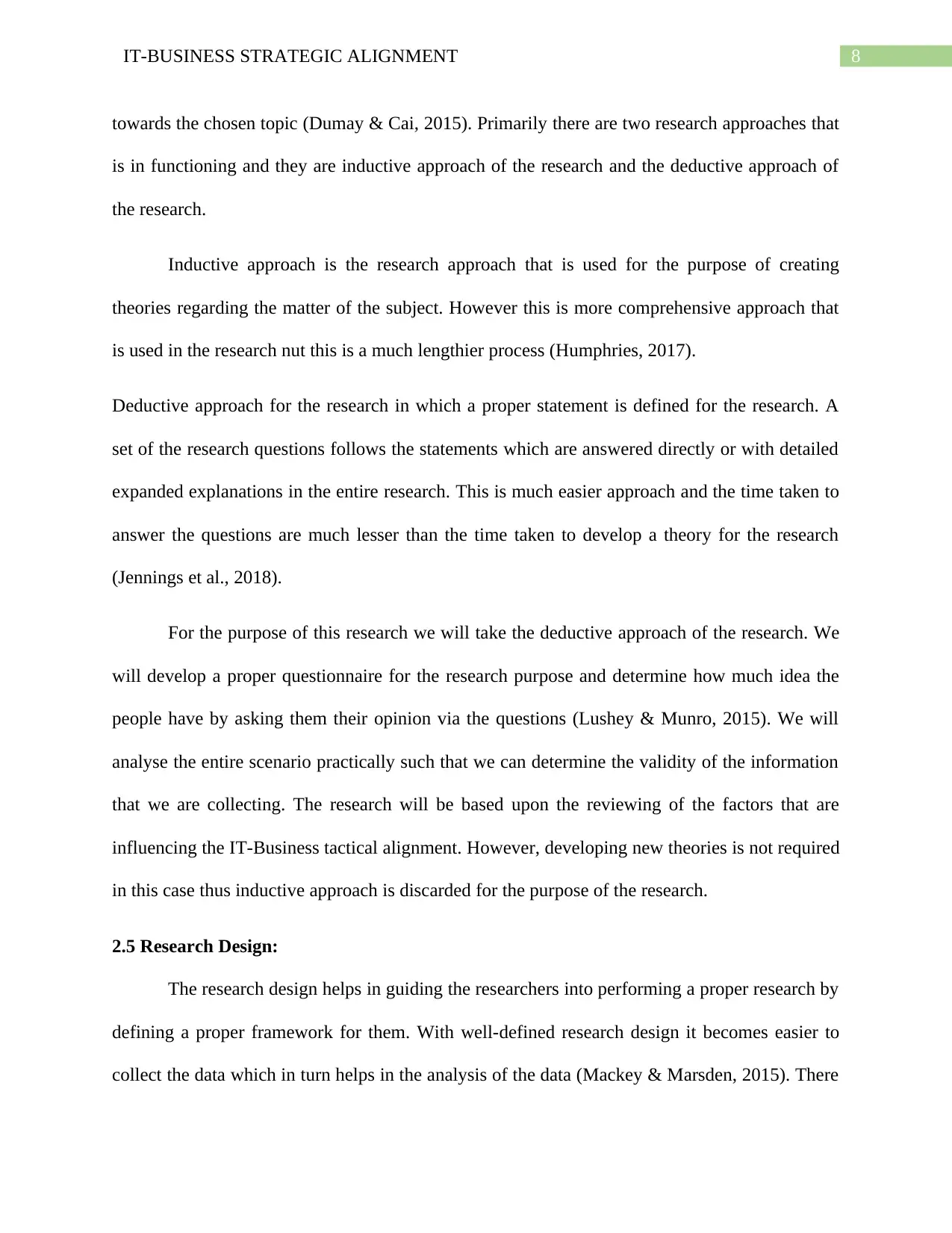
8IT-BUSINESS STRATEGIC ALIGNMENT
towards the chosen topic (Dumay & Cai, 2015). Primarily there are two research approaches that
is in functioning and they are inductive approach of the research and the deductive approach of
the research.
Inductive approach is the research approach that is used for the purpose of creating
theories regarding the matter of the subject. However this is more comprehensive approach that
is used in the research nut this is a much lengthier process (Humphries, 2017).
Deductive approach for the research in which a proper statement is defined for the research. A
set of the research questions follows the statements which are answered directly or with detailed
expanded explanations in the entire research. This is much easier approach and the time taken to
answer the questions are much lesser than the time taken to develop a theory for the research
(Jennings et al., 2018).
For the purpose of this research we will take the deductive approach of the research. We
will develop a proper questionnaire for the research purpose and determine how much idea the
people have by asking them their opinion via the questions (Lushey & Munro, 2015). We will
analyse the entire scenario practically such that we can determine the validity of the information
that we are collecting. The research will be based upon the reviewing of the factors that are
influencing the IT-Business tactical alignment. However, developing new theories is not required
in this case thus inductive approach is discarded for the purpose of the research.
2.5 Research Design:
The research design helps in guiding the researchers into performing a proper research by
defining a proper framework for them. With well-defined research design it becomes easier to
collect the data which in turn helps in the analysis of the data (Mackey & Marsden, 2015). There
towards the chosen topic (Dumay & Cai, 2015). Primarily there are two research approaches that
is in functioning and they are inductive approach of the research and the deductive approach of
the research.
Inductive approach is the research approach that is used for the purpose of creating
theories regarding the matter of the subject. However this is more comprehensive approach that
is used in the research nut this is a much lengthier process (Humphries, 2017).
Deductive approach for the research in which a proper statement is defined for the research. A
set of the research questions follows the statements which are answered directly or with detailed
expanded explanations in the entire research. This is much easier approach and the time taken to
answer the questions are much lesser than the time taken to develop a theory for the research
(Jennings et al., 2018).
For the purpose of this research we will take the deductive approach of the research. We
will develop a proper questionnaire for the research purpose and determine how much idea the
people have by asking them their opinion via the questions (Lushey & Munro, 2015). We will
analyse the entire scenario practically such that we can determine the validity of the information
that we are collecting. The research will be based upon the reviewing of the factors that are
influencing the IT-Business tactical alignment. However, developing new theories is not required
in this case thus inductive approach is discarded for the purpose of the research.
2.5 Research Design:
The research design helps in guiding the researchers into performing a proper research by
defining a proper framework for them. With well-defined research design it becomes easier to
collect the data which in turn helps in the analysis of the data (Mackey & Marsden, 2015). There
⊘ This is a preview!⊘
Do you want full access?
Subscribe today to unlock all pages.

Trusted by 1+ million students worldwide
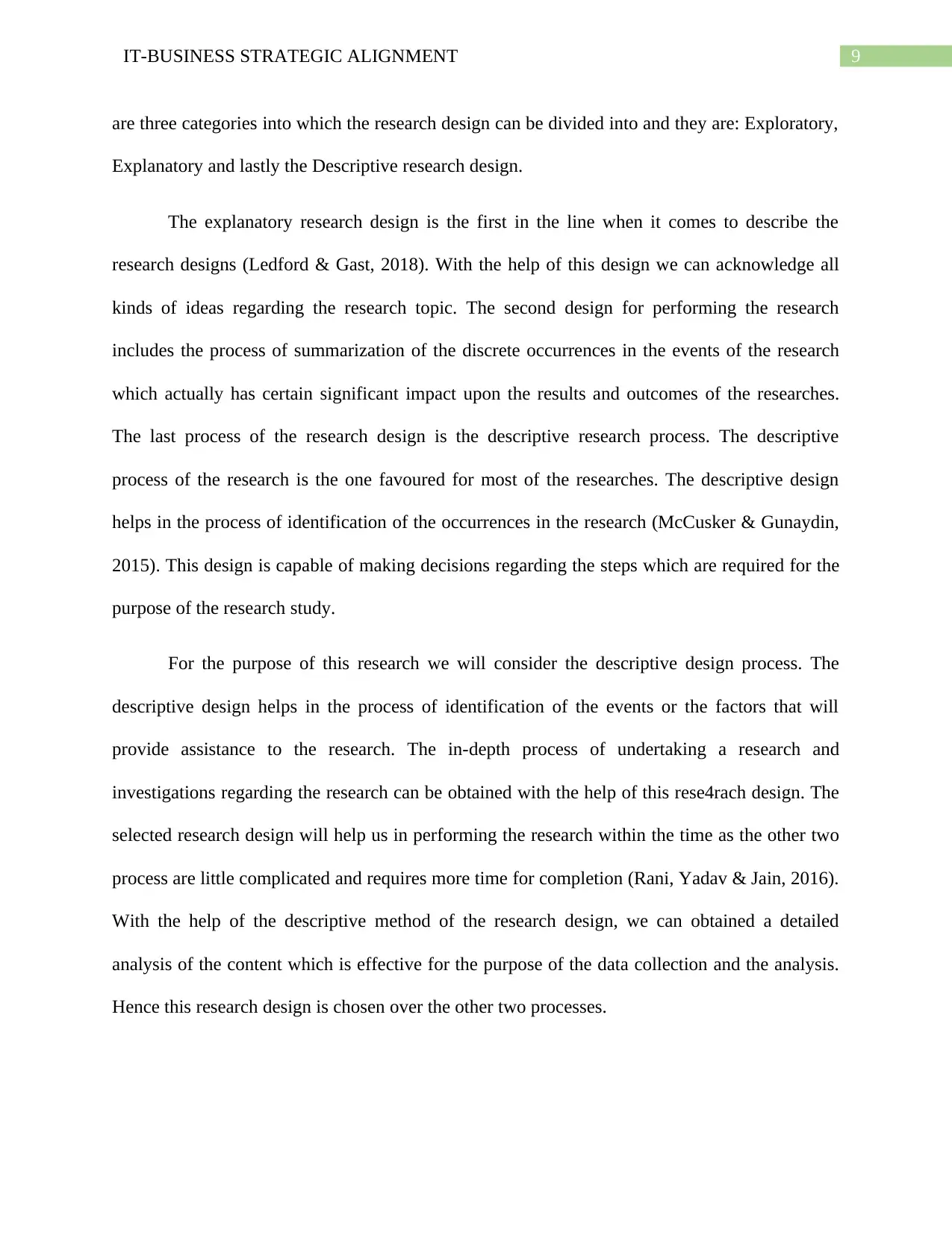
9IT-BUSINESS STRATEGIC ALIGNMENT
are three categories into which the research design can be divided into and they are: Exploratory,
Explanatory and lastly the Descriptive research design.
The explanatory research design is the first in the line when it comes to describe the
research designs (Ledford & Gast, 2018). With the help of this design we can acknowledge all
kinds of ideas regarding the research topic. The second design for performing the research
includes the process of summarization of the discrete occurrences in the events of the research
which actually has certain significant impact upon the results and outcomes of the researches.
The last process of the research design is the descriptive research process. The descriptive
process of the research is the one favoured for most of the researches. The descriptive design
helps in the process of identification of the occurrences in the research (McCusker & Gunaydin,
2015). This design is capable of making decisions regarding the steps which are required for the
purpose of the research study.
For the purpose of this research we will consider the descriptive design process. The
descriptive design helps in the process of identification of the events or the factors that will
provide assistance to the research. The in-depth process of undertaking a research and
investigations regarding the research can be obtained with the help of this rese4rach design. The
selected research design will help us in performing the research within the time as the other two
process are little complicated and requires more time for completion (Rani, Yadav & Jain, 2016).
With the help of the descriptive method of the research design, we can obtained a detailed
analysis of the content which is effective for the purpose of the data collection and the analysis.
Hence this research design is chosen over the other two processes.
are three categories into which the research design can be divided into and they are: Exploratory,
Explanatory and lastly the Descriptive research design.
The explanatory research design is the first in the line when it comes to describe the
research designs (Ledford & Gast, 2018). With the help of this design we can acknowledge all
kinds of ideas regarding the research topic. The second design for performing the research
includes the process of summarization of the discrete occurrences in the events of the research
which actually has certain significant impact upon the results and outcomes of the researches.
The last process of the research design is the descriptive research process. The descriptive
process of the research is the one favoured for most of the researches. The descriptive design
helps in the process of identification of the occurrences in the research (McCusker & Gunaydin,
2015). This design is capable of making decisions regarding the steps which are required for the
purpose of the research study.
For the purpose of this research we will consider the descriptive design process. The
descriptive design helps in the process of identification of the events or the factors that will
provide assistance to the research. The in-depth process of undertaking a research and
investigations regarding the research can be obtained with the help of this rese4rach design. The
selected research design will help us in performing the research within the time as the other two
process are little complicated and requires more time for completion (Rani, Yadav & Jain, 2016).
With the help of the descriptive method of the research design, we can obtained a detailed
analysis of the content which is effective for the purpose of the data collection and the analysis.
Hence this research design is chosen over the other two processes.
Paraphrase This Document
Need a fresh take? Get an instant paraphrase of this document with our AI Paraphraser
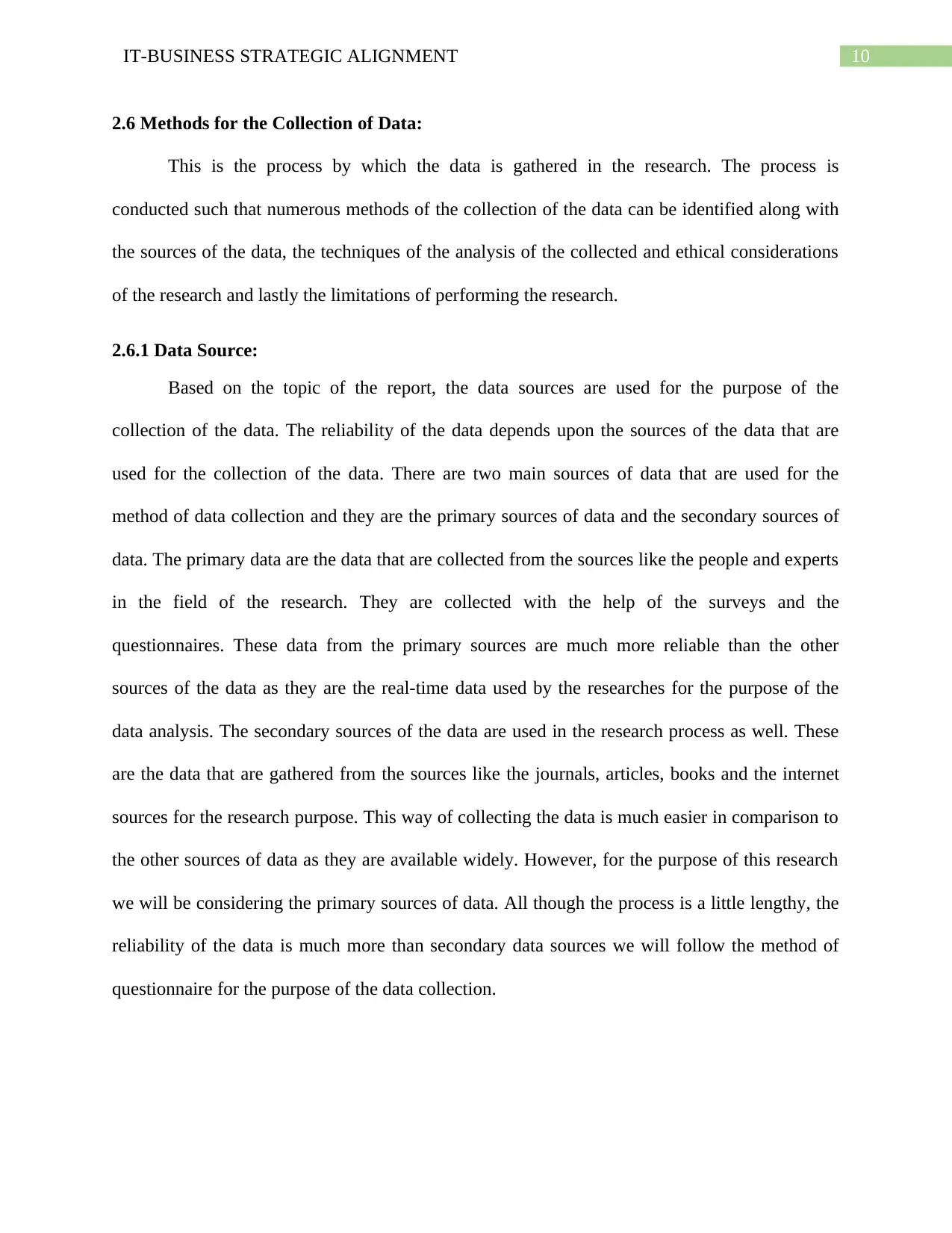
10IT-BUSINESS STRATEGIC ALIGNMENT
2.6 Methods for the Collection of Data:
This is the process by which the data is gathered in the research. The process is
conducted such that numerous methods of the collection of the data can be identified along with
the sources of the data, the techniques of the analysis of the collected and ethical considerations
of the research and lastly the limitations of performing the research.
2.6.1 Data Source:
Based on the topic of the report, the data sources are used for the purpose of the
collection of the data. The reliability of the data depends upon the sources of the data that are
used for the collection of the data. There are two main sources of data that are used for the
method of data collection and they are the primary sources of data and the secondary sources of
data. The primary data are the data that are collected from the sources like the people and experts
in the field of the research. They are collected with the help of the surveys and the
questionnaires. These data from the primary sources are much more reliable than the other
sources of the data as they are the real-time data used by the researches for the purpose of the
data analysis. The secondary sources of the data are used in the research process as well. These
are the data that are gathered from the sources like the journals, articles, books and the internet
sources for the research purpose. This way of collecting the data is much easier in comparison to
the other sources of data as they are available widely. However, for the purpose of this research
we will be considering the primary sources of data. All though the process is a little lengthy, the
reliability of the data is much more than secondary data sources we will follow the method of
questionnaire for the purpose of the data collection.
2.6 Methods for the Collection of Data:
This is the process by which the data is gathered in the research. The process is
conducted such that numerous methods of the collection of the data can be identified along with
the sources of the data, the techniques of the analysis of the collected and ethical considerations
of the research and lastly the limitations of performing the research.
2.6.1 Data Source:
Based on the topic of the report, the data sources are used for the purpose of the
collection of the data. The reliability of the data depends upon the sources of the data that are
used for the collection of the data. There are two main sources of data that are used for the
method of data collection and they are the primary sources of data and the secondary sources of
data. The primary data are the data that are collected from the sources like the people and experts
in the field of the research. They are collected with the help of the surveys and the
questionnaires. These data from the primary sources are much more reliable than the other
sources of the data as they are the real-time data used by the researches for the purpose of the
data analysis. The secondary sources of the data are used in the research process as well. These
are the data that are gathered from the sources like the journals, articles, books and the internet
sources for the research purpose. This way of collecting the data is much easier in comparison to
the other sources of data as they are available widely. However, for the purpose of this research
we will be considering the primary sources of data. All though the process is a little lengthy, the
reliability of the data is much more than secondary data sources we will follow the method of
questionnaire for the purpose of the data collection.
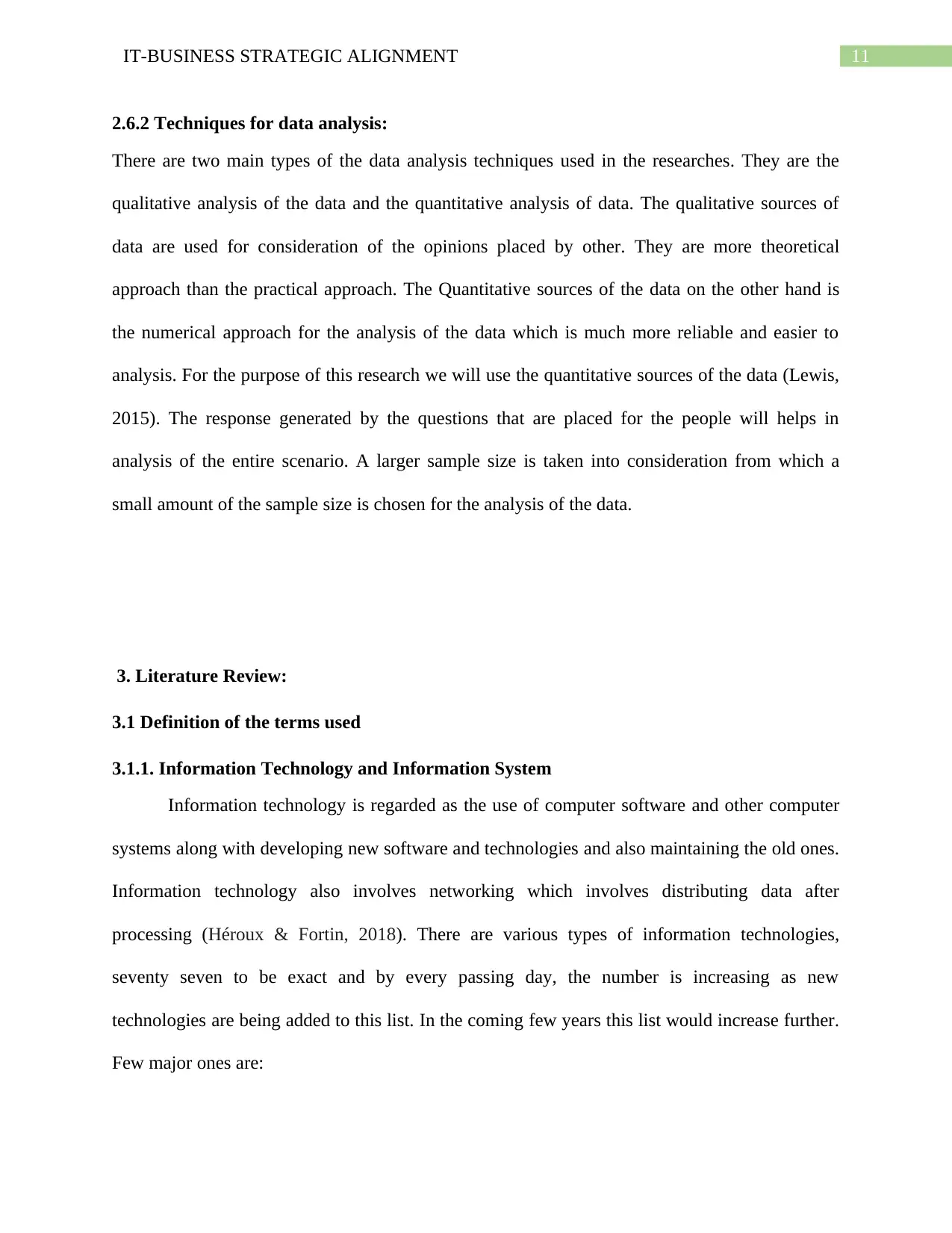
11IT-BUSINESS STRATEGIC ALIGNMENT
2.6.2 Techniques for data analysis:
There are two main types of the data analysis techniques used in the researches. They are the
qualitative analysis of the data and the quantitative analysis of data. The qualitative sources of
data are used for consideration of the opinions placed by other. They are more theoretical
approach than the practical approach. The Quantitative sources of the data on the other hand is
the numerical approach for the analysis of the data which is much more reliable and easier to
analysis. For the purpose of this research we will use the quantitative sources of the data (Lewis,
2015). The response generated by the questions that are placed for the people will helps in
analysis of the entire scenario. A larger sample size is taken into consideration from which a
small amount of the sample size is chosen for the analysis of the data.
3. Literature Review:
3.1 Definition of the terms used
3.1.1. Information Technology and Information System
Information technology is regarded as the use of computer software and other computer
systems along with developing new software and technologies and also maintaining the old ones.
Information technology also involves networking which involves distributing data after
processing (Héroux & Fortin, 2018). There are various types of information technologies,
seventy seven to be exact and by every passing day, the number is increasing as new
technologies are being added to this list. In the coming few years this list would increase further.
Few major ones are:
2.6.2 Techniques for data analysis:
There are two main types of the data analysis techniques used in the researches. They are the
qualitative analysis of the data and the quantitative analysis of data. The qualitative sources of
data are used for consideration of the opinions placed by other. They are more theoretical
approach than the practical approach. The Quantitative sources of the data on the other hand is
the numerical approach for the analysis of the data which is much more reliable and easier to
analysis. For the purpose of this research we will use the quantitative sources of the data (Lewis,
2015). The response generated by the questions that are placed for the people will helps in
analysis of the entire scenario. A larger sample size is taken into consideration from which a
small amount of the sample size is chosen for the analysis of the data.
3. Literature Review:
3.1 Definition of the terms used
3.1.1. Information Technology and Information System
Information technology is regarded as the use of computer software and other computer
systems along with developing new software and technologies and also maintaining the old ones.
Information technology also involves networking which involves distributing data after
processing (Héroux & Fortin, 2018). There are various types of information technologies,
seventy seven to be exact and by every passing day, the number is increasing as new
technologies are being added to this list. In the coming few years this list would increase further.
Few major ones are:
⊘ This is a preview!⊘
Do you want full access?
Subscribe today to unlock all pages.

Trusted by 1+ million students worldwide
1 out of 29
Related Documents
Your All-in-One AI-Powered Toolkit for Academic Success.
+13062052269
info@desklib.com
Available 24*7 on WhatsApp / Email
![[object Object]](/_next/static/media/star-bottom.7253800d.svg)
Unlock your academic potential
Copyright © 2020–2025 A2Z Services. All Rights Reserved. Developed and managed by ZUCOL.



